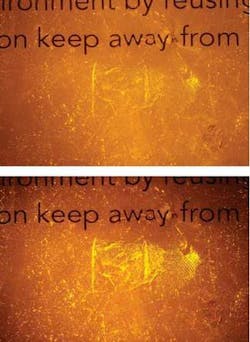OPTICALLY PUMPED LASERS: Coherent seeks third-time charm in forensic laser

In April, the third generation of forensic-laser technology at Coherent (Santa Clara, CA) became a contender for handheld applications such as illuminating fingerprints at crime scenes. The first generation, launched 30 years ago, found popularity in crime labs because Stokes-shift fluorescence made fingerprints much easier to read, according to product manager David Clark. Green laser light was absorbed and stimulated inherent fluorescence in the orange or yellow (see figure). Unfortunately, size, weight, and power requirements for the large-frame argon-ion lasers used at that time were too high for use outside of the laboratory; the need for handheld portable forensic illumination has been met since then primarily by lamp-based technology.
In the late 1990s, however, Coherent introduced its second-generation laser for forensic applications, a diode-pumped solid-state (DPSS) laser that was dubbed “the incriminator.” The green continuous-wave laser was mounted on a cart with a chiller in a system, and weighed 170 to 180 lb in total. The cart made the system semiportable, Clark says, but it remained too expensive for use by a typical sheriff’s office. Despite the functional advantages of laser illumination, the system remained too large, heavy, cumbersome, and costly for most crime-scene applications.
The third-generation system, however, is based on optically pumped semiconductor-laser (OPSL) technology that Coherent began developing about a decade ago with initial applications in bioinstrumentation. During the past few years power levels have been achieved that enable use in forensic applications. Clark likened OPSL operation to that of a disk laser, except that the active OPSL medium is a semiconductor chip with a multiple-quantum-well cavity that is pumped from above with a high-power laser-diode bar. Unlike a disk laser, the pump light does not have to make multiple passes through an absorptive layer, but is absorbed in an efficient single pass through a thin (few-micron) surface layer grown using molecular-beam epitaxy upon a highly reflective mirror.
Relatively simple optics focus light onto the 1 to 2 mm2 surface area of the chip. As long as the pump wavelength exceeds the bandgap energy, all the light is absorbed without any need for close temperature control to match the absorption peak of a particular laser material, Clark said. The output wavelength is also tunable, as opposed to being dependent upon natural frequency, such as the 1064 nm of neodymium-doped laser materials. A fiber-delivery system eliminates laser speckle.
“It is basically a third-generation laser that has been taken into the forensic space,” Clark said. Battery power enabling 1.5 hours of operation and a total system weight of 45 lb make it portable enough to actually transport to a crime scene.
About the Author
Hassaun A. Jones-Bey
Senior Editor and Freelance Writer
Hassaun A. Jones-Bey was a senior editor and then freelance writer for Laser Focus World.